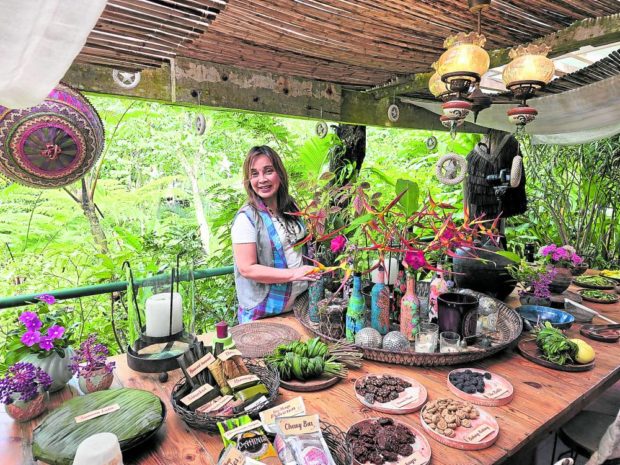
Tucked in a forest is Sen. Loren Legarda’s “Eden,” her haven away from the bustle of her very busy daily life.
It was to a quaint yet very homey repurposed cottage that she welcomed me, with a warm cup of tarragon tea, that she grows in her herb garden.
It was a day meant to explore the possibilities of working together to support her culinary heritage program, the preservation of Philippine tribal cuisine and the advancement of food processing in the province of Antique.
For me, as a teacher, the most pressing matter was to finally give the senator a final push to cook her first dish.
See, during one of our conversations, she intimated how cooking was a skill she was hoping to acquire. I challenged her to try her hand at it, and she gladly accepted.
So, off we strolled to her vegetable patch to harvest the vegetables needed to cook linapwahan, a soupy vegetable dish from Antique, similar to our dinengdeng but seasoned with patis and muscovado, made flavorful by the addition of hibe and kalkag.
We harvested malunggay, saluyot, upo, kalabasa, kulutis and tanglad. Vegetables in the senator’s patch are aplenty. “We don’t buy vegetables. What we eat, we grow,” she said proudly.
I learned that linapwahan is a dish that dates back to the precolonial period. The dish varies according to the mix of vegetables and the type of fish or shrimp in the recipe.
From the garden, we proceeded to her beautiful open kitchen. It was so whimsical that it looked like it was from a doll house.
Many talents
Though the senator cannot cook, her talents are plenty—she builds, arranges, rearranges, repurposes and refurbishes. There is no such thing as waste for Loren. Whatever her hand touches is transformed. She has an innate gift of putting things together beautifully. Things that to the ordinary eye won’t work, work with Loren’s magic touch. Well-appointed clutter, if there is such a thing, is her forte. She has a distinct taste, her own style and a method to her artistic madness.
I was in awe of her kitchen. It was simply captivating, especially with her charcoal fired palayok cookware.
Her long wooden dining table was made even prettier by flowers, handpicked from the garden with old hand-painted bottles as vases.
Her kitchen was an idyllic representation of provincial life. It was not grand, but it was charming, homey, warm and welcoming.
In fact, even her recipe choice was so simple, yet when we were done with it and plated on her mismatched stoneware pottery bowls, the dish took on a new form.
Served alongside our linapwahan was a green salad made out of homegrown lettuce and dragon fruit (both of which we harvested earlier with the vegetables) drizzled with a honey vinaigrette. There, too, was a warm bowl of sinigang na libas.
Perfectly cooked
Loren likes to eat rather simply. Her everyday food is prepared closest to its natural state and devoid of frills.Her linapwahan was a success. The vegetables were cooked perfectly, though I seasoned it behind her back, to my heart’s content. Otherwise, it would have tasted too healthy for me.
After lunch, we feasted on the many kakanin from Antique. The varieties of kakanin from all over our archipelago are truly amazing!
The interesting ones were the puto tapul, putong Antique made with black rice and huwad-huwad made from ground glutinous rice, coconut milk and muscovado. The mixture is poured into cylindrical banana leaves and steamed. Huwad means “to pour.” Sinakol is made of cassava filled with coconut meat cooked in muscovado.
Overstuffed, we took a stroll to see her Ifugao houses, of which she has two, the Mayoyao and the Kiangan, which are beautiful. According to the senator, they are more than decorative as she used to sleep in them.She walked me farther down to her COVID lockdown office, which was essentially just a beautiful old table, sandwiched between two ferns, out in the open, in the middle of her “jungle”-style garden.
Her munting paraiso, as I dub it, is a work in progress. Here and there are patches of DIY projects that she designs, draws and decorates on her own.
Indeed, Loren wears many hats—lawmaker, architect, interior designer, furniture maker, painter, floral artist—and on that day, she began her journey as a cook.
Legarda’s “linapwahan”
Senator Loren’s ‘Linapwahan’
1/8 kg diced kalabasa5 stalks malunggay¼ kg kamote leaves
¼ kg tagabang (saluyot)
1/4 kg kulitis (native spinach)
6 pc okra cut into wedges
1 pc singwa (upo)
1/4 kg kalkag1/4 kg hibeSalt to taste or patis (fish sauce)
2 tomatoes
2 red onions
2 cloves garlic, pounded
2 lemongrass hearts, bruised
Pinch of muscovado sugar
4 c water
Bring water to a boil. Add hibe and kalkag according to taste. Add the garlic, onion, tomato and tanglad. Add vegetables—those that take longer to cook go first. The leafy greens go in only before serving. Simmer until vegetables are cooked to your desired doneness. Season with muscovado and patis to taste. This is delicious!
The senator and I will soon launch our initiative to support various causes that are close to our hearts, such as the construction of kitchens for our tribal communities where they will be free to cook meals for themselves and their loved ones. This will be an opportunity for us to observe how food is done their way, and to document it for generations to come.
We are also in the process of gathering heirloom recipes, for the preservation of our culinary heritage. There is indeed much to look forward to!
www.reggieaspiras.com; @iamreggieaspiras on Instagram and Facebook.